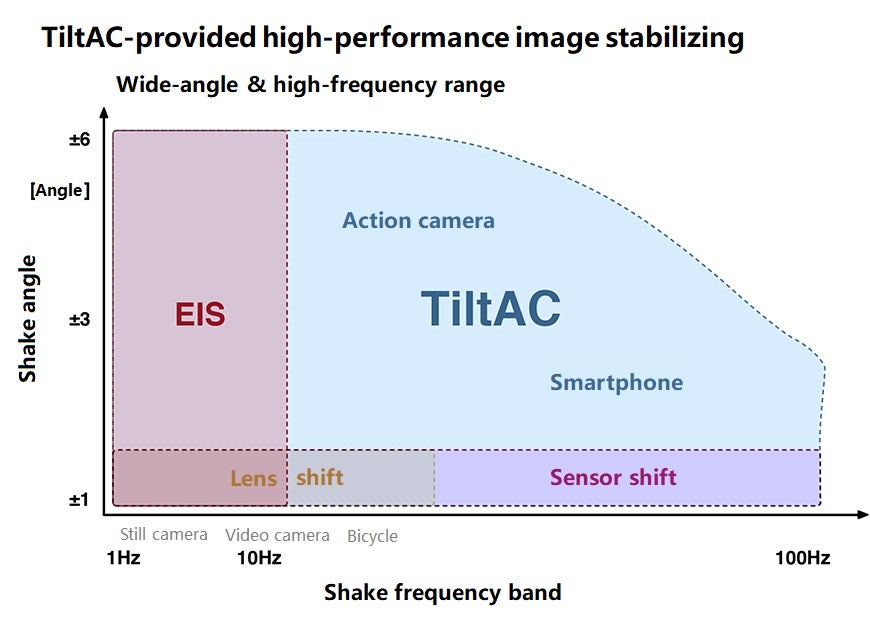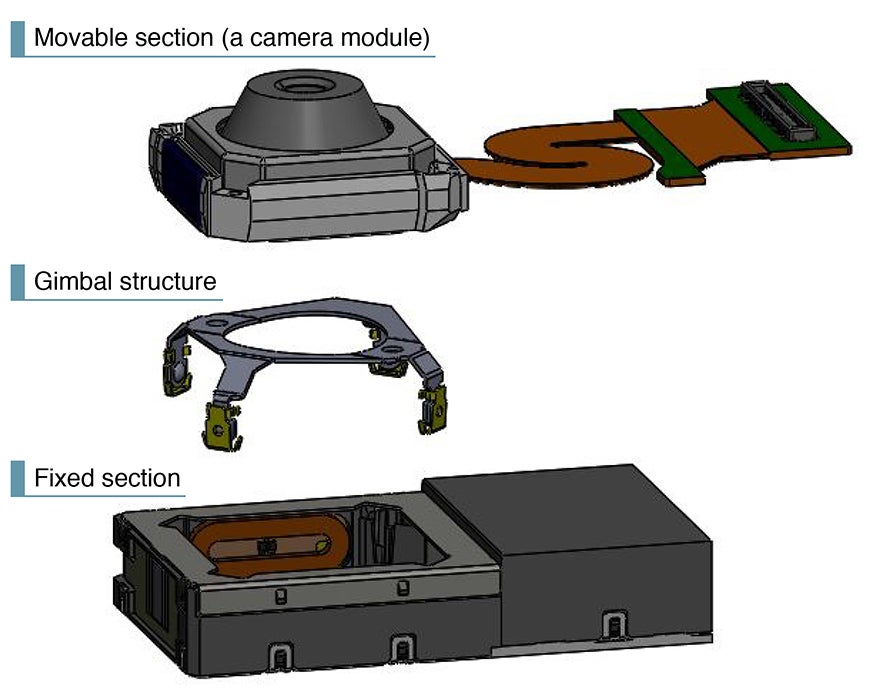Implemented Solutions
Image-stabilizing mechanism, TiltAC
- NEEDS
- Supply smartphones that a user can shoot shake-free images casually.
- SOLUTION
- Provide a gyro-sensor-equipped image-stabilizing function that controls the entire shooting module’s posture
Image-stabilizing mechanism that controls actuators precisely to optimize the performance smartphone cameras
At present, it is said that 1.4 billion smartphones are shipped out into the global market every year. Each one of the devices is equipped with a camera function, and shooting images of everyday life with a smartphone is part of life for many generations of people. In the past, cameras, even those for professional photographers, would require users to hold them tightly to prevent shakes. In recent smartphones, however, there is a powerful image-stabilizing function equipped that enables a user to shake-free photos and moving images, even when the person holds a phone with one hand, and presses its shutter casually.
NIDEC INSTRUMENTS supplies TiltAC, a shake-cancelling function that works in conjunction with a gyro sensor. This function is gaining attention in the smartphone industry as an image-stabilizing device that maximizes a lens’s and a sensor’s performance without deteriorating imaging quality.
So far, various image-stabilizing technologies have been realized for digital and video cameras. The OIS (Optical Image Stabilizer) method, which shifts the shakes of a lens or a CMOS sensor (a shooting element) to a cancelling direction to maintain a light axis at the center, has long been used for single-lens reflex and other cameras. On the other hand, the EIS (Electronic Image Stabilizer) method, which processes digital data to extract part of a shot image to stabilize it, is being installed into smartphones and other devices in recent years. Due to their mechanisms, though, these methods could not avoid the depletion of imaging quality: The OIS method, in which image-stabilizing movements keep the positional relationship of the lens and the CMOS sensor from their ideal conditions, creates distortion especially on the periphery of still and moving images that have been shot. In addition, the EIS method is not able to fully utilize the CMOS sensor’s innate effective pixel area – another reason for the imaging quality to decline.
To the contrary, TiltAC, which handles the entire camera module – from the lens to the sensor – as a movable section, controls an actuator’s movements precisely to keep the gyro sensor from causing tilt displacement (angular velocity), and keeps the camera module looking straight at the object. This is why TiltAC does not cause images to deplete around the periphery, maximizes the CMOS sensor’s performance, and its user can casually shoot high-quality images, still and moving.


In addition to maintaining imaging quality, TiltAC far supersedes other methods in accommodating tilt displacement. While the OIS method can function practically with tilt displacement of up to ±1º approximately, TiltAC corrects a camera module’s tilt even with a large shake angle of ±6º. This feature enables a photographer to shoot shake-free still and moving images, and do so in a freer shooting environment.
This innovative image-stabilizing technology was born out of NIDEC INSTRUMENTS’s long-nurtured precision servo technology known as the VCM (Voice Coil Motor) technology. The VCM is a single-phase motor where only a coil reciprocates in a strong magnet-generated magnetic field. Since when feature phones were mainstream, NIDEC INSTRUMENTS has been supplying VCM-equipped auto focus mechanisms. In 2011, the company newly entered into the image-stabilizing market to utilize this super-fine and -refined machining technology and the company’s long-nurtured expertise.
Despite these significant advantages over other methods, there are strict requirements – other than quality – in this highly competitive smartphone market. To fit the mechanism into the thin and small space inside a smartphone’s body, the entire image-stabilizing function, including the camera module, must be made as small as possible; however, with a small magnet coil, power consumption must increase to secure a sufficient amount of movement. As an image-stabilizing mechanism supplier, NIDEC INSTRUMENTS must continue the search for the best conditions that meet both requirements.
In addition, based on the assumption that smartphones will be dropped and used roughly, the function must meet shock resistance performance and reliability requirements, to prove that it meets its requirements even after a smartphone is dropped from a 150cm height 30 times, and from a 10cm height several tens of thousands of times. Thus, NIDEC INSTRUMENTS examines everything about TiltAC – from its housing to soldering – to meet people’s demands.

The currently supplied TiltAC can stabilize images based on two axes (pitch, or a vertical rotation, and yaw, a horizontal rotation). NIDEC INSTRUMENTS is developing a triaxial image-stabilizing function that can perform roll (rotation in the light axial direction) corrections as well. In addition, for a telephoto lens to secure a long focal point distance in a narrow body, a prism is used to bend the light axis by 90º to lead to the CMOS sensor. At present, NIDEC INSTRUMENTS is developing a TiltAC that accommodates a prism-equipped camera module as well. The market’s expectations are growing on this new product, as more precise image stabilizing is required for telephotographic shooting.
In the future, the needs for the “shake-free” lens will increase in the robotic field as an essential component to move robots vividly. Discussions are underway to go beyond the camera image-stabilizing application, and install a laser module in TiltAC. When a laser module-equipped TiltAC is installed in a car, it will be able to measure inter-vehicular distance more accurately than before, and TiltAC may become a key device to further develop the autonomous driving technology in the future.
